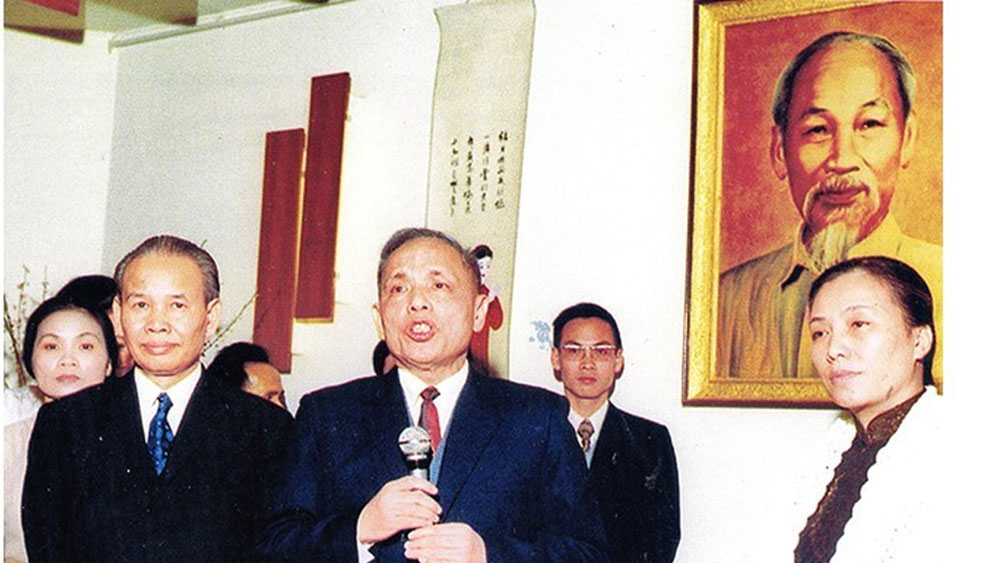A touching story about Uncle Ho’s portrait
Visiting the headquarters of the Association at No.16 on the small street of Petit Musc in District 4 of Paris, many people were surprised to see that a portrait of President Ho Chi Minh, which was scorched in a corner, was still hanging solemnly above his altar.
 |
|
On January 28, 1973, Foreign Minister Nguyen Duy Trinh, Head of the Delegation of the Democratic Republic of Vietnam Xuan Thuy and Head of the delegation of the Provisional Revolutionary Government of the Republic of South Vietnam Nguyen Thi Binh visited the Vietnamese Association in France after signing the Paris Agreement. |
For overseas Vietnamese in France, this is the most beautiful and meaningful portrait in both art and history because it is associated with the patriotic movement in France.
Nguyen Van Bon, former Chairman in charge of foreign affairs of the Vietnamese Association in France, said that on the occasion of the opening of the Association's Headquarters in 1971, Xuan Thuy, Head of the negotiating delegation of the Government of the Democratic Republic of Vietnam at the Paris Conference, came to congratulate the Association and presented a portrait of President Ho Chi Minh - a very meaningful gift for overseas Vietnamese here and people often call it “Portrait of Uncle Ho”.
Since 1971, the headquarters of the Vietnamese Association in France at Petit Musc Street, purchased and renovated by expatriates, is the official gathering place of Vietnamese people towards the homeland.
Not only is it a meeting place and organising activities for dear Vietnam, there is also a portrait of Uncle Ho, the founder of the Patriotic Annamite Group in 1919 (the name of the Patriotic Overseas Vietnamese Movement in France and is the predecessor of the Vietnamese Association in France today).
For the same reason, this is the target of attacks of supporters of the Saigon government. The first time happened at dawn on April 30, 1975 (French time) when the South was liberated.
The solid gate of the association's headquarters was broken, many places inside were damaged, but fortunately the portrait was still intact. The second time was at noon on February 14, 1980, when the association was again burned by the haters. The French press at that time reported that some fascists had attacked the headquarters of Vietnamese patriots.
Some of them rushed in to throw incendiary substances and injured Nguyen Cong Hoan, a member of the Workers’ Union, assigned to be on duty at the headquarters. Hoan tried to put out the fire that spread to many areas and burned the portrait. After that, some members of the association, followed by the police and firemen, intervened in time.
Over many terms, the association's leaders agreed to maintain the status quo, considering it a living proof of patriotism and respect for the great leader of the Vietnamese people, including overseas Vietnamese in France. Over the years, the picture has still been sharp and retained its colour as it was in the beginning.
It is considered a great source of encouragement for Vietnamese people to uphold their patriotism, regardless difficulties and dangers, towards the country during the war and in subsequent reconstruction and development.
Nguyen Van Bon recalled: The Paris Agreement also marked a prominent period in the patriotic movement of the Vietnamese community in France, those who were wholeheartedly united and towards the homeland.
Uncle Ho, the embodiment of patriotism and aspiration for national liberation, was always by their side to give more strength and faith to overseas Vietnamese about a reunion day of the North and the South.
He left priceless heritage, which is the unshakable will: independence and national reunification. Therefore, overseas Vietnamese in France have done their best to protect the sacred image of the nation’s old father.
Every year, on Uncle Ho’s birthday, National Day on September 2 or on New Year’s Eve, the Vietnamese Association in France and the seniors in the Workers’ Union and descendants of the Vietnamese community come here to burn incense in memory of him and remind each other to continue the patriotic tradition, to be grateful to Uncle Ho and to look forward to the homeland.
Every time French and international friends visit the headquarters of the association, the story of Uncle Ho's portrait is proudly told.
Source: NDO
 Bắc giang
Bắc giang














Reader's comments (0)